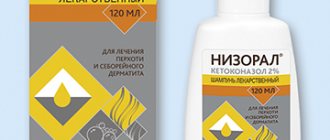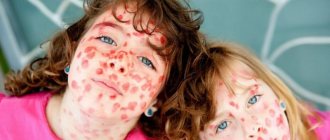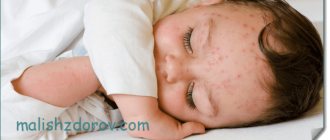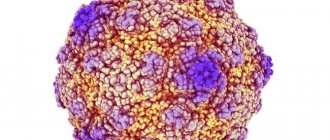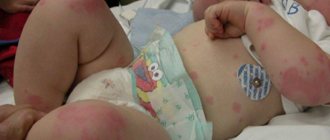If streptoderma appears on your hands, you should immediately consult a specialist. He will be able to correctly diagnose and prescribe treatment. Delay in this case threatens to spread the rash throughout the body. After all, the disease is caused by staphylococcus.
The blisters that form on the arms and legs are constantly itching. However, they cannot be injured; a scar may form at the site of the tumor.
What is streptoderma?
Childhood streptoderma is a purulent skin disease of an infectious nature.
The pathology is characterized by purulent rashes on the baby’s body, which causes discomfort and can lead to infection of the child’s blood. Photos of streptoderma in a child can be found freely available on the Internet.
Streptoderma is bacterial in nature - the main causative agent of the disease is streptococcus. This pathology is also called streptococcal pyoderma.
The sources of infection are most often patients with streptoderma and carriers. However, the disease can be transmitted to a child through household items, toys, or if the baby has lesions on the skin.
Streptoderma is transmitted through contact and household contact. There are known cases of transmission of the pathogen by airborne droplets, when the pathogen came into contact with the baby’s damaged skin as a result of coughing or sneezing of a patient or carrier of the infection.
Causes
The causative agent of the disease is streptococcus, which enters the body through damaged skin. Most often, streptoderma affects children in kindergartens, junior grades of educational institutions, as well as various sections.
The cause of infection may be:
- Poor personal hygiene;
- Frequent overwork;
- Reduced immunity;
- Stressful situations;
- Lack of vitamins and microelements;
- Microtraumas.
The infection is transmitted through clothing, dishes, dust, and toys. In the summer, the infection is spread by insects on their legs.
Types of infection
Today there are a large number of types of this infection:
- Streptococcal impetigo;
- Bullous impetigo;
- Slit-like impetigo;
- Erythematosquamous impetigo;
- Tourniol;
- Streptococcal diaper rash.
All these types of infections are united by the presence of one pathogen, which affects the child’s body differently and causes various purulent-inflammatory diseases.
Possible complications
Patients often have a question: how dangerous is the disease, and what could be the consequences? A sick person, when in contact with a healthy person, becomes a source of infection.
If the doctor’s recommendations are not followed or hygiene rules are neglected, streptoderma in children and adults becomes chronic, the infection can enter the systemic bloodstream, provoke the development of streptococcal sore throat, autoimmune pathologies (rheumatism, endocarditis), cause intoxication of the body, damage to internal organs.
Microbial eczema may appear at the site of long-term non-healing wounds; after regeneration, scars remain on the skin. Often a fungal infection occurs, which subsequently requires complex treatment. Prolonged streptoderma is complicated by the formation of guttate psoriasis and skin atrophy. The most serious consequence is blood poisoning, which can possibly lead to death.
Causes of streptoderma
The main cause of the pathology is streptococcus, which entered the child’s body through areas of damaged skin on the baby’s body.
The infection does not enter the body on its own; many factors contribute to this, such as:
- Weakened immune system of the child;
- Damage to the baby's skin;
- Violation of child hygiene;
- Pathologies in the endocrine system (rare);
- Sudden changes in climatic and temperature conditions of the child’s stay;
- Burn wounds;
- Some diseases - anemia, malnutrition, worms;
- Contact with water for a long time.
It is important to note that a pathology such as streptoderma is seasonal, most often appearing in summer and late spring. This is due not only to the stability of temperatures, but also to the fact that the child is currently more susceptible to the influence of external agents.
Many people are concerned about the question: is childhood streptoderma really contagious? The answer to this question is yes.
When do the first teeth appear in babies: when do they appear, the first symptoms and the order of teething (95 photos and videos)Do children need ergoferon and why - instructions for use, recommendations and reviews from doctors (95 photos and videos)
Why there might be a bump on a child’s head: what to do and how to treat it quickly and easily. Modern and traditional methods of getting rid of cones (105 photos and videos)
This statement can be confirmed by the presence of outbreaks of the epidemic in preschool and school institutions. One sick child or carrier causes illness in many other children.
Treatment with medications
Experts treat this phenomenon with pharmaceutical drugs. During illness, it is forbidden to take a bath or shower. This recommendation is due to the fact that the infection does not multiply on dry skin. The rash is treated with chamomile solution, and the area around it with 70° alcohol or brilliant green.
In order for lesions on the body to heal faster, they should be lubricated with one of the following products:
- Levomekol.
- Gentamicin ointment.
- Syntomycin ointment.
It is best to apply the drug to gauze or a tampon and secure it to the affected area with an adhesive tape. This procedure is recommended to be done at night. In the morning, the bandage is removed, and the rash is treated with alcohol or brilliant green.
Streptoderma is also treated with hormonal ointments - triderm, celestoderm and others. However, these drugs should be prescribed by a doctor, since they have many contraindications, but they allow you to cure the disease in a short time. In some cases, antibiotics are prescribed. This disease develops when the immune system is weakened, so it is recommended to also take a multivitamin.
Symptoms of the disease
The disease has many different types, the main differences being the location on the body and the shape of the rash.
However, all types of streptoderma have similar clinical symptoms, caused by one pathogen and a toxic effect on the baby’s body.
The various stages of streptoderma in children (bullous and non-bulous) depend on the time the pathological agent is in the child’s body, manifesting itself first by an increase in symptoms, and then by a gradual decrease.
Common symptoms include:
- The appearance of a fever in a child - the temperature of the food reaches high levels and can reach 39 ° C;
- Rashes on the body with purulent foci;
- After a few days, the rashes burst and redness with a yellow crust remains in place, which disappears after a few more days;
- Rashes on the body are accompanied by unbearable itching and often the child scratches the redness until ulcers appear, which also aggravates the process.
Causes of scrofula in children: signs, main symptoms, diagnosis and treatment (105 photos)- Fenistil for newborns - when it is prescribed, for whom it is contraindicated and when to use the drug (125 photos)
The first symptoms of cough in infants - causes, types, features and tips on how to treat coughs and colds (125 photos)
Depending on the type of streptoderma, the pathological agent can be located in different parts of the body.
The total duration of the disease can range from 3 days to 4 weeks - it depends on the state of immunity and on how much the pathological agent spreads throughout the body.
Symptoms of streptoderma in children can be aggravated if treatment is not started in a timely manner.
If the process of the appearance of ulcers is started, then a chronic form of pathology may appear, which is characterized by a severe course and the constant presence of large areas of lesions on the child’s skin.
Folk remedies
This disease can be cured using traditional methods. To do this, you can use improvised means. It is recommended to first treat the rash with hydrogen peroxide and then brilliant green. The procedure must be done twice a day.
An infusion of calendula and clover gives good results. These components are mixed in equal quantities, then 20 grams of the mixture are taken, 200 ml of boiling water is poured in and infused for 24 hours. Use this product to wipe the rashes three times a day.
A decoction of yarrow also gives good results for this ailment. You will need to pour boiling water over 10 grams of dry raw materials and keep it in a water bath for 20 minutes. The broth is then filtered and used to wipe the skin.
An infusion of chamomile or oak bark will also help get rid of the disease. You will need to mix these components in equal quantities. Then 40 grams of the mixture is poured with 400 ml of boiling water and left for 20 minutes. After this time, the solution is filtered, gauze is soaked in it and applied to the affected areas for 15 minutes. It will need to be changed at least 6 times per procedure. As a result, its duration will be 1.5 hours. It is recommended to do it three times a day.
Streptoderma will go away quickly if you treat problem areas with calendula tincture. This product can be purchased at a pharmacy or made independently.
To do this, you will need to pour 50 grams of flowers with 50 ml of alcohol and leave for 5 days. Then the product is filtered, diluted with boiled water in a 1:1 ratio and applied to the affected areas of the skin.
Sage decoction compresses give good results. To prepare it, you need to pour 500 ml of boiling water into 150 grams of dry raw materials. Then the container is placed on low heat and boiled for 20 minutes. After which the product is filtered, gauze is soaked in it and applied to the inflamed areas of the skin.
A decoction of string is another excellent remedy for this scourge. To prepare it, you should take 20 grams of raw materials, pour 300 ml of boiling water and boil in a water bath for 40 minutes. Then the broth is filtered and used in the form of lotions. Streptoderma usually goes away in 7 days, you just need to apply compresses regularly.
Basic treatment methods
Many people are concerned with the question of how to treat streptoderma at home, but it is worth understanding that therapy must be carried out under the strict supervision of a specialist in compliance with all instructions.
The main method of treating the disease is the use of drugs and ointments that attack the streptococcal agent.
Plantex for newborns - instructions for using medicine to improve digestion in the smallest (135 photos and videos)- Vitamins for hair: selection of a vitamin complex for skin and nails. Rating of effective vitamin complexes for hair growth (130 photos)
The first signs of otitis in children - the main causes, symptoms, forms, diagnosis and treatment of the disease (145 photos and videos)
During therapy, drying ointments containing an antimicrobial effect are used. Broad-spectrum antibiotics are also mandatory in treatment.
There are a number of mandatory measures required during the treatment of streptoderma:
- During an infection, do not wash or wet the affected areas;
- Moisturizing ointments should not be used;
- In parallel with antibacterial therapy, it is necessary to carry out immunoprophylaxis of the body.
- In some cases, antibiotic treatment should be accompanied by prebiotics.
To summarize, we can come to the conclusion that streptoderma is a rather dangerous and insidious disease that requires full treatment and an integrated approach to combating infection.
It is important to take preventive measures to avoid such pathology.
Reasons for development
The main reason for the appearance of pathology is the weakening of the body’s defense system. Bacteria that are part of the microflora of the mucous membranes and skin begin to multiply rapidly, causing symptoms of streptoderma.
Provoking factors include:
- prolonged hypothermia;
- rhinitis;
- previous viral and cold diseases;
- poor hygiene;
- circulatory disorders;
- intoxication of the body;
- following strict diets;
- hypovitaminosis;
- frequent stress;
- helminthic infestation;
- exacerbation of chronic diseases of internal organs.
Most often, streptoderma is diagnosed in young children. The cause of the pathology is not fully formed immunity. Frequent runny nose leads to maceration of the skin and soft tissues, creating favorable conditions for the active growth of pathogenic bacteria.
Photo of streptoderma in a child
streptoderma in the nose
I haven’t written for a long time, I don’t have time at all, although that’s no excuse)
Over the past month, or rather during the first month of the New Year, quite a few significant events have happened, there were both good and bad. Let's go in order.
On the night of January 1, we had a fever, and we went to visit, in the end I stayed with Timokha all night, didn’t even go to the chimes (again I didn’t make a wish). And so the temperature stayed for several days, in the end I called a doctor, they somehow got to us, and also paid 200 rubles for a taxi (this is Russia, baby). They said we have teeth. Then everything seemed to calm down. And just as we were overjoyed, I noticed that my son’s finger was festered, at first we tried to treat ourselves, and in the end we went to the clinic (our holidays are still going on). There they tell us that we don’t know what it is, go to the hospital. We went for the first time to our children's hospital, where we were diagnosed with streptoderma, the pustules were opened and the finger was bandaged. How he cried, his heart sank, they took him away alone, it seems to me that he was even more frightened of this (During these days, it seems to me that I have aged, I was very worried, Timofey took off the bandages, but it was impossible, I was freaking out. Then all week we went to physio , or rather we went, since money was already running short. But TTT everything seemed to have gone away. A very nasty sore.
Well, the good thing is the completion of the GW)) How long I’ve been working towards this, how much I’ve been dreaming, and now it’s happened) by the way, unexpectedly. And we really began to sleep better! But now we eat 2-3 times at night. But for me, after a year of sleepless nights, this is grace)
And I began to eat better too. Now my head hurts about how to cook something tastier, because I’m still a gourmet guy)) I made tasteless meatballs, tried to feed them for two days - to no avail, then I made cheese soup - that’s the only way I devoured it)
By the way, Tim eats like a big guy. He tries everything I eat. And just dare not give it to him! Such a scandal will roll)
I tried the chocolate, but now I can’t show it to him at all, it’s straight into his mouth, and it’s still too early!
He began to walk more and more, he probably almost always walks. Funny like Mishka)
But here’s the problem: he refuses to wear shoes. Immediately hysterics, screaming and tears. I don’t know what we will do in the spring...
He plays with toys reluctantly and rarely, with the exception of probably cars (Man). And basically he follows me around all day, that’s what I call him)
She loves to dance, especially while watching TV)
He has become very smart and cunning, he understands everything, everything) I’m already afraid when he starts talking)
We still don’t have a routine, well, more precisely, we do, but not exactly according to the clock like some people do.
He is very attached to me, to the point of horror. Reluctant to make contact with other adults. Smiles and waves only for his own people)
With photos a little later, you need to take some time for yourself)
